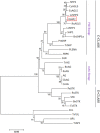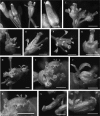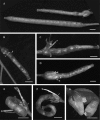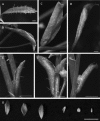Ectopic expression of IiSHP2 from Isatis indigotica Fortune, a PLE-lineage MADS-box gene, influences leaf, floral organ and silique morphology in Arabidopsis thaliana
- PMID: 32158142
- PMCID: PMC7036382
- DOI: 10.1007/s12298-019-00745-6
Ectopic expression of IiSHP2 from Isatis indigotica Fortune, a PLE-lineage MADS-box gene, influences leaf, floral organ and silique morphology in Arabidopsis thaliana
Abstract
In order to ascertain the regulatory mechanism of fruit development in Isatis indigotica Fortune, the complementary DNA (cDNA) sequence of the SHATTERPROOF 2 (SHP2) orthologous gene was identified by Rapid Amplification of cDNA Ends technology and the corresponding gene was named IiSHP2. The expression pattern of IiSHP2 was determined by quantitative reverse transcription-polymerase chain reaction and wild-type Col-0 Arabidopsis plants were transformed with the IiSHP2 gene using Agrobacterium tumefaciens and the floral-dip method. Expression analyses indicated that IiSHP2 was highly expressed in flowers, silicles and seeds. Compared to wild-type plants, IiSHP2 transgenic lines bolted earlier. Detailed phenotypic observations showed that the size of the rosette and cauline leaves in transgenic lines was reduced and the cauline leaves of the transgenic lines were incurved and displayed a funnel-like shape. During the reproductive growth stage, IiSHP2 transgenic plants produced shortened sepals and the flower buds were not encapsulated completely. Moreover, the petals of the transgenic lines were converted into stamineous tissues, accompanied by exposed stamens, short malformed siliques and wrinkled valves, indicating a severe decline in fertility. These experimental conclusions are valuable as a reference for the breeding of medicinal plants.
Keywords: Floral differentiation; IiSHP2; Isatis indigotica Fortune; MADS-box gene; Silique development.
© Prof. H.S. Srivastava Foundation for Science and Society 2020.
Conflict of interest statement
Conflict of interestThe authors declare that they have no conflict of interest.
Figures










Similar articles
-
IiSVP of Isatis indigotica can reduce the size and repress the development of floral organs.Plant Cell Rep. 2023 Mar;42(3):561-574. doi: 10.1007/s00299-023-02977-z. Epub 2023 Jan 7. Plant Cell Rep. 2023. PMID: 36609767
-
Ectopic expression of IiFUL isolated from Isatis indigotica could change the reproductive growth of Arabidopsis thaliana.Plant Physiol Biochem. 2017 Dec;121:140-152. doi: 10.1016/j.plaphy.2017.10.014. Epub 2017 Nov 6. Plant Physiol Biochem. 2017. PMID: 29102902
-
SEPALLATA--like genes of Isatis indigotica can affect the architecture of the inflorescences and the development of the floral organs.PeerJ. 2022 Mar 1;10:e13034. doi: 10.7717/peerj.13034. eCollection 2022. PeerJ. 2022. PMID: 35251790 Free PMC article.
-
Cloning of a SEPALLATA4-like gene (IiSEP4) in Isatis indigotica Fortune and characterization of its function in Arabidopsis thaliana.Plant Physiol Biochem. 2020 Sep;154:229-237. doi: 10.1016/j.plaphy.2020.05.031. Epub 2020 Jun 10. Plant Physiol Biochem. 2020. PMID: 32563851
-
A SEPALLATA1-like gene of Isatis indigotica Fort. regulates flowering time and specifies floral organs.Gene. 2019 Sep 10;713:143974. doi: 10.1016/j.gene.2019.143974. Epub 2019 Jul 10. Gene. 2019. PMID: 31301484
Cited by
-
Characterization of MADS-Box Gene Family in Isatis indigotica and Functional Study of IiAP1 in Regulating Floral Transition and Formation.Plants (Basel). 2025 Jan 4;14(1):129. doi: 10.3390/plants14010129. Plants (Basel). 2025. PMID: 39795389 Free PMC article.
-
Isatis indigotica: from (ethno) botany, biochemistry to synthetic biology.Mol Hortic. 2021 Dec 14;1(1):17. doi: 10.1186/s43897-021-00021-w. Mol Hortic. 2021. PMID: 37789475 Free PMC article. Review.
-
A MADS-Box Gene CiMADS43 Is Involved in Citrus Flowering and Leaf Development through Interaction with CiAGL9.Int J Mol Sci. 2021 May 14;22(10):5205. doi: 10.3390/ijms22105205. Int J Mol Sci. 2021. PMID: 34069068 Free PMC article.
References
-
- APG An update of the Angiosperm Phylogeny Group classification for the orders and families of flowering plants: APG II. Bot J Linn Soc. 2003;141:399–436. doi: 10.1046/j.1095-8339.2003.t01-1-00158.x. - DOI
LinkOut - more resources
Full Text Sources
